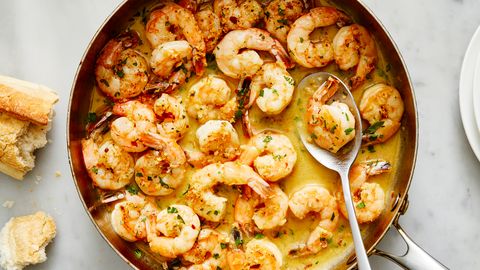If you open up nearly any pantry in the United States, you’re bound to find a bottle of olive oil. It’s the foundation of many salad dressings, the perfect dip for bread, and can even be the star of a moist and fluffy cake. Olive oil is popularity is palpable: in 2021, Americans consumed 406,000 metric tons of it.
When you’re in the oil aisle of your grocery store, you’re greeted with rows and rows of different types of olive oil. But the one heralded the most by brands across the board is “extra virgin.” But what exactly does that mean?
We’re here to unpack exactly what extra virgin olive oil is, how it’s different from other oils, and how to cook with it.
What Is Extra Virgin Olive Oil?
The term “extra virgin olive oil” may make you do a double take, but its definition is pretty straightforward. Let’s break it down. First, as the name suggests, olive oil is extracted from the fruits of the olive tree. What makes it “virgin” is the means by which the olives’ natural oils are extracted.
According to the International Olive Council (IOC), virgin olive is made using mechanical or other physical methods. Another important factor is that the process does not include any conditions, namely high heat, that denature or otherwise alter the natural oil.
These international standards don’t necessarily apply to every bottle in American supermarkets, however. Federal regulations state that following the IOC’s standards is voluntary, which has led to widespread mislabeling and fraud. According to a 2010 UC Davis review of 19 popular American olive oil brands, 70 percent of extra virgin olive oil bottles didn’t meet the standards required for the “extra virgin” label.
To ensure that the extra virgin olive oil you’re buying is the real deal, look out for official seals and certifications from third party organizations like the IOC or the California Olive Oil Council.
The Difference Between Extra Virgin And Other Types Of Olive Oil
The primary distinction between extra virgin and just virgin is the amount of free fatty acids (and no, they don’t make your olive oil sour). Free fatty acids are created when the natural fat molecules in olive oil break down. This can happen either through oxidation during the production process or from using overripe, damaged, or rotten olives.
So no, free fatty acids are not considered a good thing. Extra virgin olive oil has the most rigorous standards to reduce the amount of them in your bottle, with a maximum of 0.8 percent allowed. Virgin olive oil has a maximum of 2.0 percent, but how it reaches that percentage can vary.
According to olive oil producer Brightland, sometimes lower quality olive oil is blended with extra virgin olive oil until the free fatty acid percentage qualifies for virgin designation. Beyond the potentially sketchy means of production, virgin olive oil also lacks the same depth of flavor, color, and aroma as extra virgin olive oil.
There are other olives oils available that lack the word “virgin” in their names entirely. Whether they go by “pure olive oil,” “light olive oil,” or just “olive oil,” these varieties go through extra rounds of processing before they end up on grocery store shelves.
Sometimes, producers will reuse already-pressed olives to extract even more oil. Other times, producers will subject oil unsuitable for human consumption (officially called “lampante”) to heat and filtration to remove free fatty acids and make it safe to eat. And lastly, other producers will combine refined olive oil with completely different oils (like soybean and canola) to lower the cost.
Benefits Of Extra Virgin Olive Oil
When you consider the stringent regulations and lack of extra processing, extra virgin olive oil is the best option from both a flavor and health perspective. When pressed at the peak of freshness and bottled without needing extra refining, olive oil can have a golden-green hue, floral and fruity aroma, and a bold, fresh flavor. Especially when drizzled on top of dishes, you can distinctly taste the flavor of high-quality olive oil.
Extra Virgin Olive oil is also touted as one of the healthiest fats available. Olive oil is rich in monounsaturated fatty acids, which help to reduce “bad” cholesterol. The FDA agrees that consuming olive oil can help your overall heart health. Another beneficial component of extra virgin olive oil is the presence of polyphenols, which are antioxidants with anti-inflammatory and cancer-fighting qualities.
Beyond the loss in flavor in processed olive oils, refinement also removes these polyphenols and minimizes the overall health benefits.
How To Use Extra Virgin Olive Oil
Extra virgin olive oil has a wide variety of applications. You can use it to build a salad dressing from scratch, to drizzle over freshly roasted vegetables, to make a homemade pomodoro sauce—the list goes on. But it doesn’t come without its limitations, namely high-heat cooking.
Because of the delicate compounds in extra virgin olive oil, they are especially susceptible to getting denatured. Just like using heat during the production process can negatively affect the oil’s quality and flavor, using extra virgin olive oil to cook food at high temperatures also alters the way it tastes. In most cases, high heat will leave extra virgin olive oil, and the food cooked in it, tasting smoky and burnt.
That doesn’t mean you shouldn’t cook with olive oil at all—in fact, extra virgin olive oil is suitable for most cooking methods. According to the North American Olive Oil Association, the average smoke point for extra virgin olive oil ranges anywhere from 350° to 410°.
The few cooking methods that exceed this number include broiling, high-temperature grilling, and searing foods like steak on high heat. So if you’re cooking food in a pan over medium heat, roasting at moderate temperatures in the oven, and even deep frying, feel free to reach for your bottle of olive oil.





